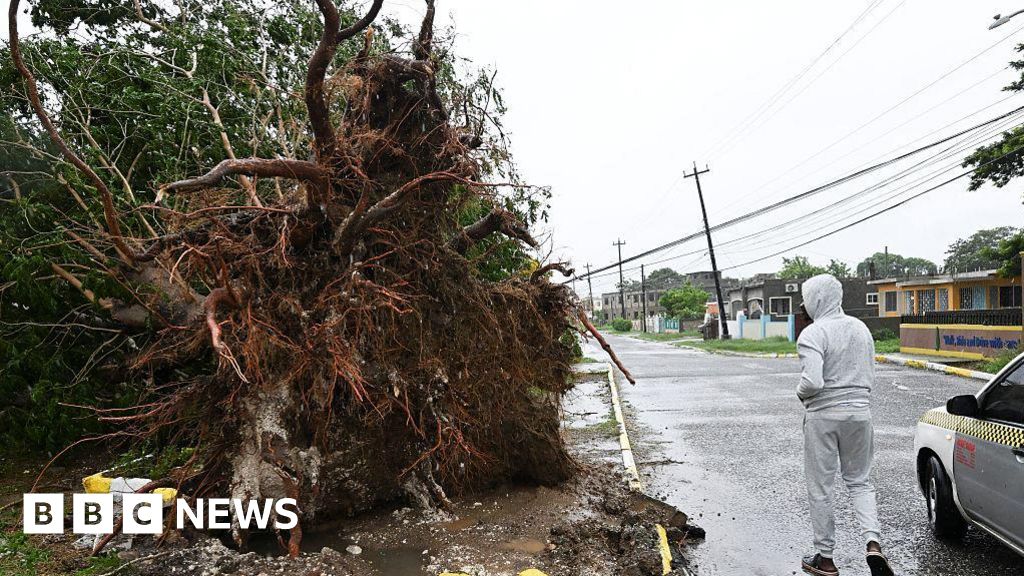Fears are growing as a 'killer' insect species is conquering new ground in the UK.
Authorities have confirmed that multiple Asian Hornets have been found in Northern Ireland for the first time.
At least two of the invasive insects have been found in eastern Belfast in the past week, according to the Northern Ireland Environment Agency (NIEA).
About about an inch in length, the Asian Hornet is capable of a painful sting that can be fatal for people with certain allergies.
The creature is distinguishable by its bright yellow leg tips, thin yellow stripes on its upper abdomen, and vibrant orange face.
More than ever, authorities are now relying on the public to report Asian Hornets and their nests so they can be destroyed by qualified pest technicians.
'This is a harmful species that I do not wish to see becoming established in Northern Ireland,' said Northern Ireland's Environment Minister Andrew Muir.
'It presents a serious threat to both biosecurity and local ecology, particularly valuable pollinating insects.'
In the last week, there have been several Asian Hornet sightings in the Dundonald area of Belfast, Northern Ireland. Officials are working to establish the location of a potential nest in the area. Pictured, one of the Asian Hornets found in east Belfast. Note the distinguishing features - bright yellow leg tips and thin yellow stripes on upper abdomen
An immediately identifiable feature of the Asian Hornet is its bright yellow leg tips compared to the European's brown legs. Note also the distinctive thick black stripes on its body
The first Asian Hornet to be found in Northern Ireland was spotted in the Dundonald area of Belfast on October 10 by a member of the public.
Since then, there have been further sightings in the Dundonald area, suggesting the existence of at least one nest there.
'Officials are working to establish location and remove any potential nest in the area,' said the Department of Agriculture, Environment and Rural Affairs in an X post.
Authorities stress suspected nests shouldn't be disturbed under any circumstances and sightings should be reported immediately on the Asian Hornet Watch app.
It's unclear how many specimens have been found in Northern Ireland; NIEA has been contacted for more information.
While the sightings in the past week are the first Asian Hornets found in Northern Ireland, they're not the first to be found on the isle.
This summer, two Asian Hornet nests were found and destroyed about 200 miles further south, in Cork, Republic of Ireland.
It followed the first identification of an Asian Hornet in Ireland in the Dublin area in 2021, although this was 'not associated with a wild viable population', Biodiversity Ireland said.
Pictured, an Asian Hornet snapped by a beekeeper at a bait station, on the roof of City Hall in Cork, August 21, 2025
Christopher O'Sullivan, Minister of State for Nature, Heritage and Biodiversity, called Asian Hornets 'a threat to our native pollinators and our biodiversity'. Pictured, a dead Asian Hornet found in Cork, Republic of Ireland, in summer 2025
The Asian Hornet
The Asian Hornet, scientific name Vespa velutina, is an invasive non-native species from Asia.
It is thought to have first arrived in France in 2004, and has since been spreading rapidly, with the first UK sighting in 2016.
It is a highly effective predator of insects, including honey bees and other beneficial species.
Queens grow up to 3cm in length, and workers up to 2.5cm.
It can cause significant losses to colonies, other native species and potentially ecosystems.
Christopher O'Sullivan, Minister of State for Nature, Heritage and Biodiversity based in Cork, called Asian Hornets 'a threat to our native pollinators and our biodiversity'.
'We must take even a single sighting very seriously,' O'Sullivan said. 'Members of the public are our eyes on the ground.
'Early detection is key if we are to prevent the establishment of this invasive species.'
The Asian Hornet, also known as the yellow-legged hornet, is native to southeast Asia and considered invasive across most of Europe.
The species was first seen in the UK in 2016 (near Tetbury in Gloucestershire) but has started to spread far more aggressively in recent years.
Sightings have so far been largely in the South East of England, with Kent being the most affected due to its proximity to France, but also in Sussex, Surrey, Hampshire and London, with isolated confirmed sightings across parts of South-West England and as far north as Yorkshire and Northumberland.
They've also recently been found in Jersey, the largest of the Channel Islands between England and France.
According to the UK government's latest online update, there's been a total of 245 confirmed Asian Hornet nests since 2016, all of which were destroyed.
Asian hornet nests are made out of wood fibres and saliva. Unfortunately, all wasp and hornet nests look similar, so the best way to identify a nest is to see the bug living in it. This is tricky because experts advise keeping your distance. Pictured, an Asian Hornet nest near Canterbury, Kent, May 2024
How to spot Asian Hornets
Asian Hornets can appear similar to the native European hornet, but there are a few key differences:
- Asian Hornets are smaller than European hornets.
- Asian Hornets have an orange head when viewed from the front.
- Their bodies are almost entirely black with fine yellow stripes and an orange 4th segment near their stinger.
- Their legs are bright yellow like they have been 'dipped in paint'.
If you do see an Asian Hornet you can report it through the 'Asian Hornet Watch' app.
The last confirmed sighting of a nest in Britain, also destroyed, was in Goodnestone, Kent on October 1.
Last month, meanwhile, there were 52 Asian Hornet nests found and destroyed in the UK, and the overwhelming majority (41) were in Kent.
The Asian Hornet is such a concern because it has a devastating impact on our native insect populations.
Asian Hornets have an appetite for Britain's wasps and honey bees, which are vitally important because they pollinate crops and wildflowers.
Earlier this year, a University of Exeter study found about 1,400 different species in the guts of Asian hornets, including bees, wasps, flies, beetles, butterflies, moths and spiders, although by far honey bees were their favourite prey.
Hornets are a lot larger than bees, although it's worth bearing in mind that not every hornet is an Asian Hornet.
Asian Hornet is often mistaken for the native and ecologically important European Hornet, which is not aggressive and doesn't typically pose a threat to healthy honey bee colonies.
'One of the easiest ways to identify them is by looking at their legs,' said Professor Helen Roy, an ecologist at UKCEH and the University of Exeter.
'Yellow-legged hornets [Asian Hornets] have yellow and brown on their legs, whereas European hornets' legs are only brown.'
Asian Hornets are also smaller and more slender than their European counterparts and have vibrant orange shading on their heads.
Asian Hornets live in oval-shaped nests constructed by a lone queen out of wood fibres and saliva, which can be found in trees, hanging down from ceilings, in the corner of sheds, and many other locations.
Unfortunately, all wasp and hornet nests look similar, so the best way to identify a nest is to see the bug living in it - although you shouldn't get too close.
From a safe distance, about 10 feet away, keep an eye on the nest to see if any hornet comes in or out of it.
In the nest's vicinity, remain calm and avoid any sudden movements, such as swatting which can provoke them.
Make sure any pets, children or people with allergies stay well away, as one sting from an Asian Hornet could kill a person who is allergic to their venom.
How to report an Asian Hornet
If you think you've seen an Asian Hornet, the best way to report any sightings is via the 'Asian Hornet Watch' app, available to download from the Apple and Android app stores.
The home screen of the app lets users submit a photo, date and location of sighting and other brief comments.
Reporting can lead to official investigation and nest destruction, which is vital for eradicating the invasive species across the UK.
A webpage of the UK Centre for Ecology & Hydrology also links to an online recording form, which likewise requests a date, photo and comments.
Members of the public can also report sightings by email to alertnonnative@ceh.ac.uk with a photo or on the Non-native Species Secretariat website.
This webpage from the British Beekeeper Association also has some helpful tips and images to help identification.
Be aware that the Asian Hornet can be confused with the native and ecologically important European hornet, which is not aggressive and doesn't typically pose a threat to healthy honey bee colonies.
Asian Hornets have yellow and brown on their legs, whereas European hornets' legs are only brown.
Asian Hornets are also smaller and more slender than their European counterparts and have vibrant orange shading on their heads.
 (1).png)
 2 weeks ago
10
2 weeks ago
10

















